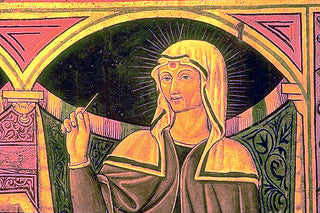In our lives, we face troubles, difficulties, and situations that seem impossible. In these moments, our faith in God must be stronger than ever. This is the real meaning of Rita da Cascia’s life and miracles, the Patroness of Impossible Causes. A saint that we celebrate on May 22nd.

Her Life: a Symbol of Humility, Kindness, and Patience
Margherita Lotti was born in 1381 in Roccaporena, a suburb of Cascia (Umbria, Italy). Her life was extremely difficult. But her unwavering faith in God gave her the strength to go on. Today, Saint Rita da Cascia is a powerful and wonderful symbol of humility, kindness, and patience.
When she was twelve years old, Rita was forced to marry a nobleman named Paolo Mancini, despite her request to become a nun. Her husband was a violent, immoral, cruel and harsh man. Rita, after years of abuse and violence, converted him into a better person. They had two sons: Giangiacomo (Giovanni) Antonio and Paulo Maria.
Paolo Mancini was killed by Guido Chiqui (at that time, there was a bloody feud between the Chiqui and Mancini families). At Paolo’s funeral, Rita forgave her husband’s murderers. A year later, her two sons, Giangiacomo and Paulo Maria, died from dysentery.
After the deaths of her husband and sons, Rita fulfilled her desire and became a nun. However, before entering the monastery of Saint Mary Magdalene in Cascia, she had to convince the other nuns: they didn’t want to admit Rita due to the scandal of her husband’s murder. Rita’s sincerity and spirit of charity were the keys that unlocked the hearts of the nuns and the doors of the monastery.
Saint Rita da Cascia spent the rest of her life in the monastery of Saint Mary Magdalene in Cascia. She died from tuberculosis on May 22nd, 1457.
Miracles
-
The levitation. According to several legends, her three patron saints (John the Baptist, Augustine of Hippo and Nicholas of Tolentino) transported her into the monastery via levitation. This event took place at night.
-
The forehead wound. At the age of sixty, while she was praying before an image of Christ crucified, St. Rita received a wound on her forehead. It was a mark, a sign that Jesus gave her because Saint Rita shared the suffering of God’s Son. As if that wound was caused by a thorn from Christ’s crown.
-
The rose. At the end of her life, Saint Rita was bedridden at the convent. She had just one desire: a rose from the garden of her old house. The saint revealed this desire to her cousin. It was January, roses don’t bloom in this month and the cousin didn’t expect to find them. Instead, in the garden of Rita’s old home, there was just one single blooming rose. The cousin brought it to Saint Rita.
-
The incorrupt body. Even after death, Saint Rita’s body has remained incorrupt. The spoils of the Saint are, still today, venerated in the shrine at Cascia.
Quotes
Even if it’s not completely confirmed, these quotes are attributed to Saint Rita da Cascia:
“There is nothing impossible to God.”
“Most Holy Sacred Heart of Jesus, help my heart to preserve in all that is holy.”
“Let me, my Jesus, share in Thy suffering, at least one of Thy thorns.”
The Patroness of Impossible Causes
Saint Rita da Cascia is the Patroness of Impossible Causes for the several difficulties that she had to face during her life. Difficulties that never, never reduced or compromised her faith in God.
How did she face so hard difficulties?
It’s easy to say: praying. God and her patron saints listened to her. And she found the way to overcome all the difficulties.
Shop now our religious medal and resin statue dedicated to Saint Rita of Cascia, Patroness of Impossible Causes.
Related Articles:
St Jude: the Patron Saint we Pray to for Impossible Causes→












